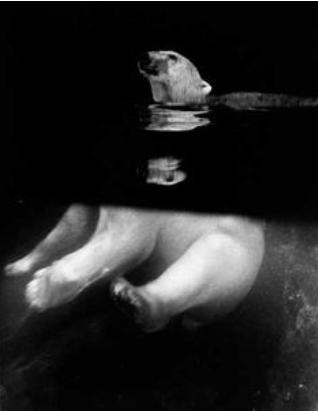by Patricia Frischer
James Balog: Photographs from the Anthropocene
Until March 10th, 2024 at the Museum of Photographic Arts, Balboa Park.
James Balog was an adventurous boy who decided to take a
camera when he climbed or hiked. He captured moments and became very skilled. Along
the way he realized that there were stories to be told. He took portrait
pictures of animals treating them as individuals, but not always in their natural habitats.
One elephant image (above) became
especially famous, but it took him years to figure out why. It was only after
reading Joseph Campbell’s book The Hero
with a Thousand Faces that he
realized that his Ganesha elephant was walking through a veil of illusion.
Balog is on a mission now to remind people that they are only one of several elements of our earth. (See his book and film The Human Element). As he states, “an imbalance in the human element leads to an imbalance in the other elements”. Humans are “changing the nature of nature”. * Humans are the only ones to redress that balance. His exhibition at the Museum of Photographic Art is James Balog: Photographs from the Anthropocene. Anthropocene is the age of humans. Some say that started 10,000 years ago, others 400 generations ago with the coming of agriculture or 225 years ago with the industrial revolution or even 60 years ago with the coming of plastic.
Time lapse proof of glaciers disappearing
He claims we no longer need to decide to believe or not
believe in climate change. Climate change is a fact proven by science. But it is
through the stories told in his images, that he can connect to the
non-scientific world. His “art is
informed by knowledge.” “An act of paying attention” where his photography and
film-making are bearing witness. Images of endangered animals, forest fires,
glaciers melting, still manage to celebrate the beauty of the world and his
wonder at the miracle of being alive.
Balog considers himself an pragmatic optimist. He is
hopeful that we can use ever developing tech to invent our way outside of the environmental
issues. His part in this is helping to shifting perceptions and showing the
evidence in real ways using art and science together.
Balog’s photographs are housed in dozens of public and
private art collections, including the Cantor Museum at Stanford University,
Agnes Gund Collection, Museum of Fine Arts Houston, Denver Art Museum,
International Center of Photography and Gilman Paper Company. He does not actively
promote his images in the fine art markets, but has sold to collectors. His
legacy will be 1000-1200 hand-picked images from 1980 to the present that a patron
has generously funded to print and will go into the Library of Congress archive as
well as that of Cornell and Yale Universities. Digital images are just not
durable in the future. He has thrown out stacks of hard drives now that storage
systems are smaller, but they are always changing.
 |
| James Balog taking photos of others at the opening of his exhibition |
James Balog has
found some valuable mental strategies that could help us all when we feel
overwhelmed in today’s difficult world: turn your despair into action,
acknowledge reality and don’t dwell in fantasy by seeking a perfect solution. Trust your tools to fix things, remember love and
community are there to help. You are not on your own.
I can add to that, learn from the past, celebrate what you
have in the present and give our younger generation the tools to survive in the
future.
 |
| James Balog and his wife: a quiet moment shared |
*Quotes from this article are taken from James Balog’s keynote
speech for 75th Anniversary University of Colorado April 2023,
although I was fortunate to interview James Balog before the opening of this
exhibition, which was also the first joint exhibition of the merger of the SDMA
and MOPA.
James
Balog: Photographs from the Anthropocene The exhibition is divided into
five sections—Survivors, Techno Sapiens, Altering Earth, On Fire, and Vanishing
Ice, which reflect
his projects over four decades. Showing until March 10th,
2024 at the Museum of Photographic Arts, Balboa Park.








No comments:
Post a Comment